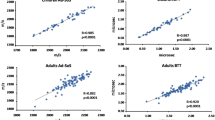Abstract:
Quantitative ultrasound (QUS) of the finger phalanges is a useful tool in the assessment of disease- or age-related deterioration of bone. For studying the impact of juvenile diseases or growth disorders affecting the skeleton, a reference database for QUS parameters is needed. The aim of this study was to establish a calibrated reference database of parameters of transverse ultrasound transmission through juvenile finger phalanges. A total of 1328 children (650 females, 678 males; ages 3–17 years) were measured in Heidelberg and Kiel in order to establish a German reference database. Highly significant gender-specific correlations (p<0.0001) were found between the QUS parameters amplitude-dependent speed of sound (AD-SoS) and bone transmission time (BTT) versus age, body height and body mass index (BMI). For AD-SoS the correlation coefficients were R 2= 0.64 against age in males and R 2= 0.73 in females, R 2= 0.60 against body height in males and R 2= 0.68 in females, and R 2= 0.19 against BMI in males and R 2= 0.23 in females. For BTT the correlation coefficients were R 2= 0.74 against age in males and R 2= 0.79 in females, R 2= 0.75 against body height in males and R 2= 0.77 in females, and R 2= 0.32 against BMI in males and R 2= 0.35 in females. Age and height were the strongest determinants of QUS results. Gender-specific differences were observed in AD-SoS (significant for ages 11–14 years and for 150–170 cm body height) and in BTT (significant for ages 7 and 11–17 years and for 160–170 cm body height). Tables of QUS parameters versus age and height can serve as a basis for the evaluation of the impact of skeletal diseases or growth disorders on phalangeal QUS. Depending on the type of disease or growth disorder, measurement results can be compared with age- or height- specific reference data. In this way a simple and radiation-free assessment of juvenile skeletal disorders using quantitative ultrasound might be possible in the future.
Similar content being viewed by others
Author information
Authors and Affiliations
Additional information
Received: 9 February 2001 / Accepted: 1 August 2001
Rights and permissions
About this article
Cite this article
Barkmann, R., Rohrschneider, W., Vierling, M. et al. German Pediatric Reference Data for Quantitative Transverse Transmission Ultrasound of Finger Phalanges. Osteoporos Int 13, 55–61 (2002). https://doi.org/10.1007/s198-002-8338-8
Issue Date:
DOI: https://doi.org/10.1007/s198-002-8338-8




